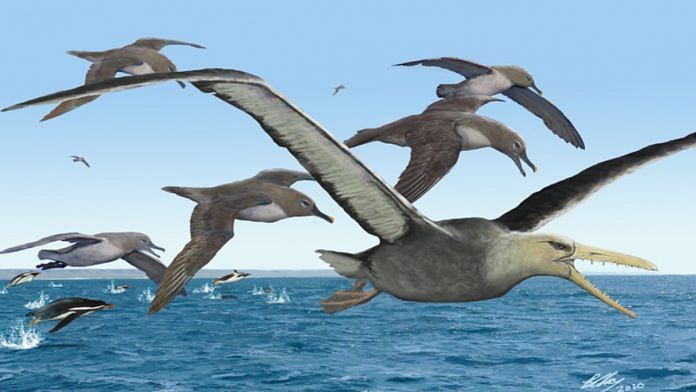Fossils from Antarctica belong to gigantic bird species
Scientists have discovered that fossils recovered from Antarctica in the 1980s belong to the oldest giant members of an extinct group of birds that patrolled the southern oceans.
The wingspans of these birds went up to 21 feet — enough to dwarf the eleven-and-a-half foot wingspan of today’s largest bird, the wandering albatross.
Called ‘pelagornithids’, the birds were much like the albatrosses, and are believed to have travelled widely over Earth’s oceans for at least 60 million years.
The team of American and Chinese researchers behind the finding believes that the birds evolved to a gigantic size relatively quickly after the extinction of dinosaurs. The last known bird of this species lived an estimated 2.5 million years ago, a time when the climate was changing as Earth cooled, and the ice ages began.
Pelagornithids are known as ‘bony-toothed’ birds because of the bony projections on their jaws. However, these protrusions are not like human teeth. Instead, they were covered by a horny material, keratin, which is like our fingernails. Called ‘pseudo teeth’, the protrusions helped the birds snag squid and fish from the sea as they soared for, perhaps, weeks at a time over much of Earth’s oceans. More on The Independent.
Also Read: ISRO’s Mars mission discovers how dust storms expand the red planet’s atmosphere
Astronomers discover 39 gravitational-wave events representing black holes, neutron stars
An international collaboration of astronomers, including scientists from India, has produced the most detailed family portrait of black holes to date by analysing the most recent gravitational-wave data.
Gravitational waves are ripples in the space-time fabric. The latest data from the LIGO Scientific Collaboration (LSC) and the Virgo Collaboration — which are two gravitational wave detectors — has helped discover 39 cosmic bodies, representing a variety of black holes and neutron stars.
The observations could be key to solving the many mysteries around how binary stars interact — a better understanding of which has consequences across the astronomy spectrum, from exoplanets to galaxy formation. More on Science Magazine.
Asteroid Bennu has been in near-Earth orbit for 1.75 million years
Scientists have found that the asteroid Bennu has been orbiting near Earth for approximately 1.75 million years.
Bennu is the asteroid that NASA’s ORISIS-Rex spacecraft touched down on this week, to collect samples. The samples are scheduled to return to Earth by 2023, which will allow scientists to learn more about the ancient past of the solar system.
To learn more about the age of the asteroid and the time it has spent orbiting near the Earth, researchers from the US focused their efforts on craters in boulders on its surface.
Previous research suggests that Bennu was once part of a larger body and was knocked off by a collision with another object while orbiting in the circumstellar disc, an asteroid belt located between Mars and Jupiter.
After the collision, Bennu slowly made its way out of the asteroid belt. It was then that it was struck by other objects, some of which hit boulders on its surface, resulting in large craters.
Even after leaving the asteroid belt, Bennu continued to be hit by other smaller objects, some of which also struck boulders on its surface. The team believes those newer strikes resulted in smaller impact craters. Since Bennu moved into a near-Earth orbit, those smaller craters have represented the timeline of its move to the new orbit.
By studying the size and depth of those craters using data from OSIRIS-Rex, the researchers were able to estimate their age — approximately 1.75 million years — which also shows how long Bennu has been near the Earth orbit. More on CNN.
Rare molecule found on Saturn’s moon puzzles scientists
NASA scientists have identified a molecule in the atmosphere of Saturn’s moon — Titan — that has never been detected in any other atmosphere. The molecule is called cyclopropenylidene, or C3H2.
“Ring-shaped molecules like this tend to act as the building blocks of molecules necessary for life, such as DNA and RNA,” New Scientist reports, adding that researchers believe it may help understand the beginning of life on Earth better.
The team found C3H2 by using a radio telescope observatory in northern Chile known as the Atacama Large Millimeter/submillimeter Array (ALMA).
Although scientists have found C3H2 in pockets throughout the galaxy, finding it in an atmosphere was a surprise, since cyclopropenylidene can react easily with other molecules it comes into contact with and form different species.
Astronomers have so far found C3H2 only in clouds of gas and dust that float between star systems. There are regions too cold and empty to facilitate many chemical reactions.
However, Titan has a dense atmosphere, which is why NASA is planning to send a probe called the ‘Dragonfly mission’ to this moon in 2034. More on New Scientist.
Also Read: Ancient Moon’s magnetic field shielded Earth from solar radiation






